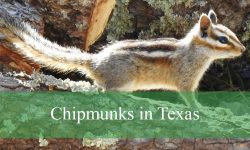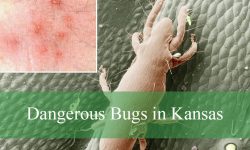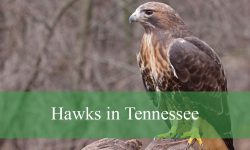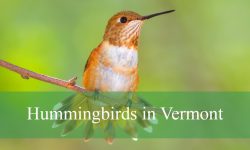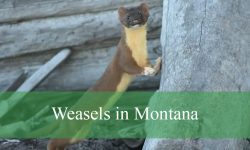If you love birdwatching, New Hampshire is a great place to see many small birds. The state has a variety of small bird species that are easy to spot in forests, parks, and even backyards. In this guide, we will introduce you to 39 small birds in New Hampshire with pictures and identification tips to help you recognize them.
Small birds in New Hampshire come in many colors and shapes. Some are bright and colorful like the American Goldfinch, while others are more subtle, like the House Wren. Knowing how to identify these birds by their size, color, and behavior will make your birdwatching experience more fun and rewarding.
This list of 39 small birds in New Hampshire provides useful information about where to find them and how to spot key features. It is a great resource for anyone interested in discovering the diverse birdlife of the region.
Common Small Birds Found in New Hampshire
Golden-crowned Kinglet

The Golden-crowned Kinglet is a tiny, energetic songbird notable for its bright yellow and black crown stripe, which is especially vivid in males. Its body is olive-green with white wing bars and pale underparts. Measuring only about 8 to 11 cm (3.1 to 4.3 inches) in length, it is one of the smallest birds in New Hampshire, yet its active movements and distinctive call make it fairly easy to detect.
This species is often identified by its rapid, restless behavior as it flits through coniferous trees, searching for small insects and spiders. Its high-pitched, thin calls and buzzing songs are characteristic sounds in New Hampshire’s forests during the colder months. The Golden-crowned Kinglet can be seen hovering briefly while foraging, showing agility despite its small size.
In New Hampshire, the Golden-crowned Kinglet prefers mature coniferous and mixed forests, often inhabiting spruce and fir stands. It is a winter visitor in the state, present mostly from late fall through early spring. This kinglet feeds primarily on tiny arthropods, making it well adapted to the cold climates typical of USDA hardiness zones 3 to 6.
Black-capped Chickadee

The Black-capped Chickadee is a small, nonmigratory songbird known for its distinctive black cap and bib contrasted against white cheeks. Its body is mostly soft gray with buffy sides and a light underbelly. This bird measures about 12 to 15 cm (4.7 to 5.9 inches) in length, making it compact and easy to spot due to its bold markings. Its characteristic “chick-a-dee-dee-dee” call gives it its name and makes it one of the most recognizable birds in New Hampshire’s woodlands.
Identifying a Black-capped Chickadee is straightforward thanks to its unique plumage and vocal patterns. It has a short neck, large head, and a short, stout bill ideal for cracking open seeds. Its behavior is active and curious, often flitting between tree branches and feeder stations with quick, darting movements. These birds often form mixed-species flocks during the winter, showing social behavior that helps them forage efficiently.
In New Hampshire, the Black-capped Chickadee inhabits deciduous and mixed forests, suburban parks, and gardens. Its diet mainly consists of insects, spiders, seeds, and berries, making it highly adaptable to seasonal changes. The bird is well-adapted to cold climates, often seen in USDA hardiness zones 3 to 7, thriving throughout the state’s forests and wooded residential areas.
Tufted Titmouse
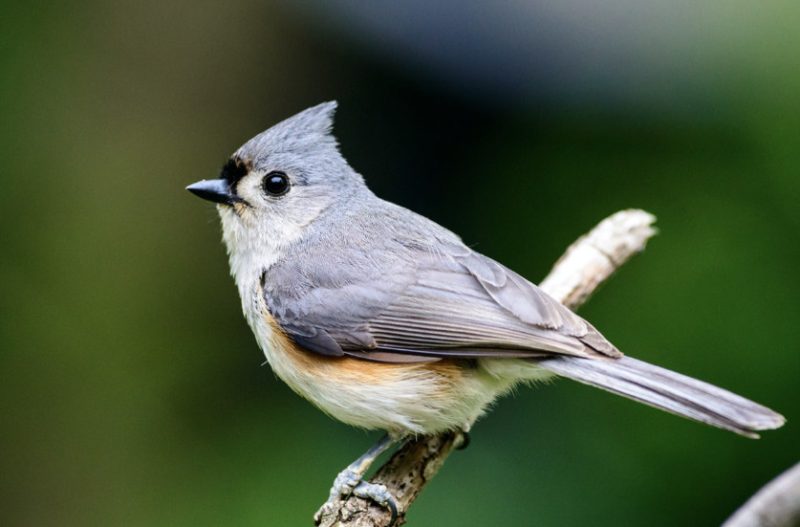
The Tufted Titmouse is a medium-small songbird with a distinctive gray crest on its head, which gives it a charming and somewhat inquisitive appearance. Its overall plumage is a soft gray with a white belly and rusty or cinnamon-colored flanks. Measuring around 14 cm (5.5 inches) long, the Titmouse has a stout body and a short, strong bill that is perfect for handling a varied diet.
This bird is easily recognizable by its loud, clear whistle that sounds like “peter-peter-peter.” The Tufted Titmouse is an active forager, often seen hopping energetically along tree trunks and branches. Its behavior includes caching food like seeds and insects in tree bark crevices to retrieve later. Its inquisitive and friendly nature often brings it close to bird feeders in backyards.
In New Hampshire, the Tufted Titmouse prefers deciduous and mixed woodlands but is also common in suburban areas with mature trees. It feeds on insects, nuts, and seeds, showing particular fondness for sunflower seeds and suet during the winter. This species is comfortable in USDA hardiness zones 4 to 8, allowing it to thrive year-round across much of the state.
White-breasted Nuthatch
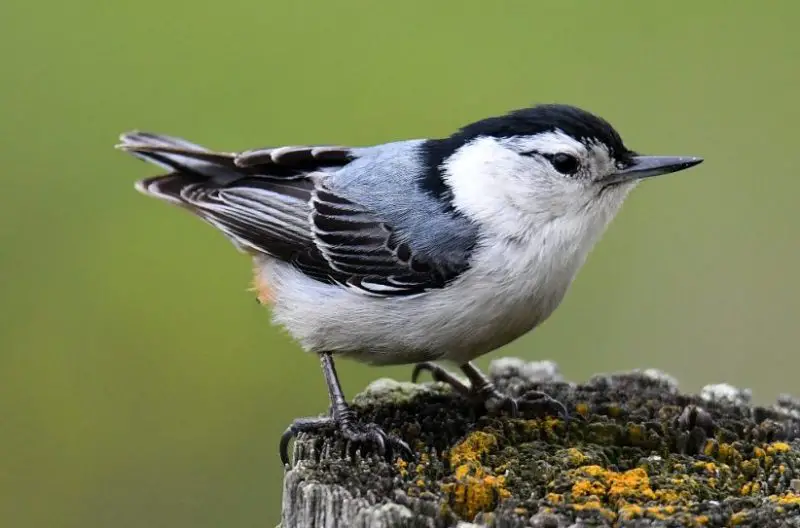
The White-breasted Nuthatch is a small bird notable for its unique behavior of creeping headfirst down tree trunks. It has a white face and underparts contrasted with a blue-gray back and wings, and a distinctive black cap on its head. About 14 to 16 cm (5.5 to 6.3 inches) in length, this bird has a long, slightly upturned bill adapted for probing bark to find insects.
Identification is easy by its habit of climbing down tree trunks and its distinctive call, a nasal “yank-yank” sound. The White-breasted Nuthatch moves deliberately and uses its strong feet and sharp claws to cling to vertical surfaces. It forages mostly on mature hardwood trees, gleaning insects and seeds from bark crevices, and it will also visit feeders for sunflower seeds and suet.
In New Hampshire, this nuthatch is common in deciduous forests, mixed woodlands, and residential areas with mature trees. It thrives in USDA zones 3 to 7 and is a year-round resident. Its diet shifts seasonally from mostly insects in warmer months to seeds and nuts in winter, reflecting its adaptability to the changing New England climate.
House Wren
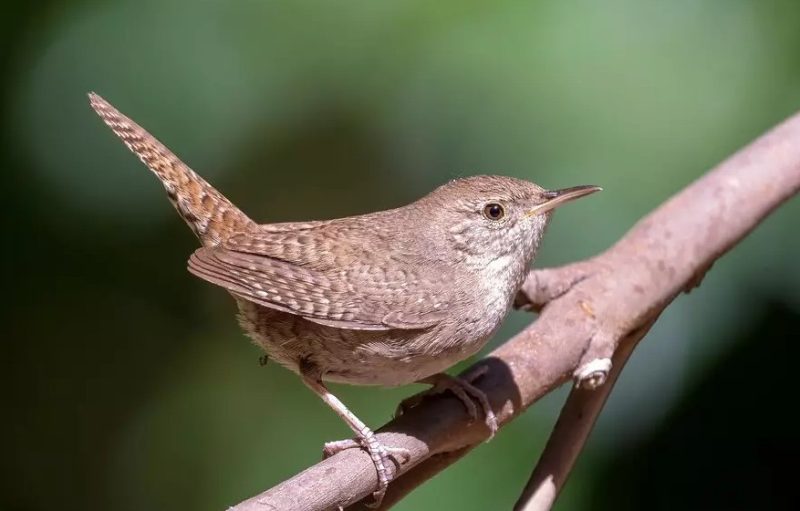
The House Wren is a small, energetic bird with a warm brown coloration and fine barring on its wings and tail. Measuring about 11 to 13 cm (4.3 to 5.1 inches), it is compact with a slightly curved bill adapted for catching insects. The bird is known for its bubbly and complex song, often delivered loudly from exposed perches despite its small size.
This species is easily identified by its restless, active behavior, often seen flitting rapidly through shrubs, thickets, and brushy areas. It nests in cavities, including human-made nest boxes, using sticks and twigs to create a cozy home. The House Wren primarily feeds on insects and spiders, making it an important pest controller in gardens and woodlands.
House Wrens are common throughout New Hampshire in forests, suburbs, and rural areas, favoring dense vegetation and brush piles for cover. They thrive in USDA zones 4 to 8, arriving in spring and staying through the summer breeding season. Their ability to adapt to various habitats and their insectivorous diet make them a valuable species in local ecosystems.
Winter Wren
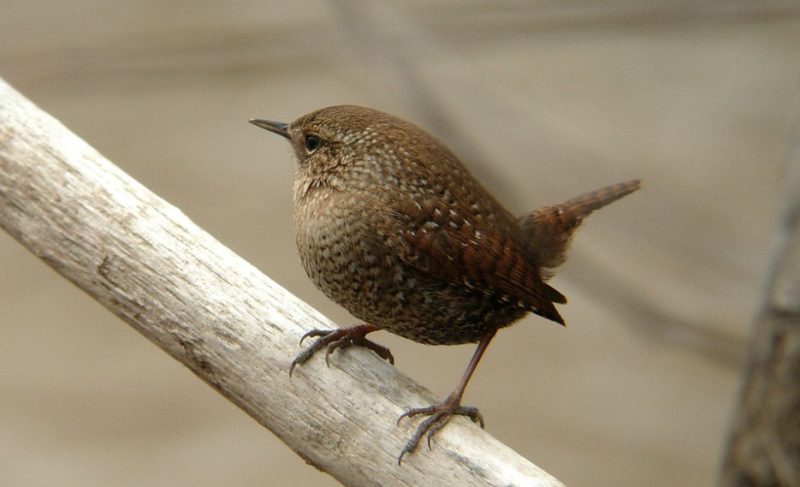
The Winter Wren is a tiny bird with a rounded body, short tail that is often held cocked upwards, and finely barred brown plumage that provides excellent camouflage among leaf litter and dense undergrowth. It measures about 10 cm (4 inches) in length, making it one of the smallest birds in New Hampshire’s forests.
Its behavior is secretive yet energetic, frequently heard before it is seen due to its loud, complex, and melodious song. The Winter Wren prefers dense, moist forest habitats with plenty of fallen logs and thick understory, where it forages actively on the forest floor for insects, spiders, and other small invertebrates.
In New Hampshire, the Winter Wren is a year-round resident, thriving in cool coniferous and mixed forests typical of the region. It is well-adapted to USDA hardiness zones 3 to 6 and is often found near streams or swampy areas. Its secretive nature and preference for dense habitats make it a rewarding but challenging species to observe.
Ruby-crowned Kinglet
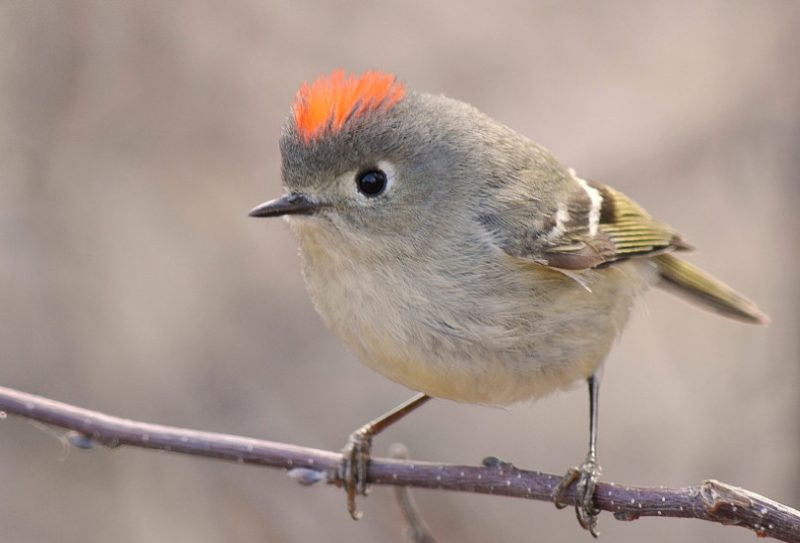
The Ruby-crowned Kinglet is a small songbird known for its olive-green plumage and the bright, red crest on the crown of the male, which is usually hidden but flared during displays. It has a white eye ring and two white wing bars. It measures about 9 to 11 cm (3.5 to 4.3 inches) in length, making it similar in size to the Golden-crowned Kinglet but slightly larger.
This bird is active and inquisitive, often flicking its wings and moving quickly through shrubs and low trees while searching for insects. Its song is a series of high-pitched, warbling notes interspersed with trills and whistles, making it a distinctive sound in spring and fall migrations. Identification can be tricky without seeing the male’s ruby crown, but its behavior and calls help birders distinguish it.
In New Hampshire, the Ruby-crowned Kinglet is a migrant and occasional breeder, favoring mixed and deciduous forests as well as shrubby areas. It frequents USDA zones 4 to 7 and is seen during spring and fall migrations as it travels between breeding grounds in the northern forests and wintering areas further south. Its diet consists mostly of small insects and spiders.
Blue-gray Gnatcatcher
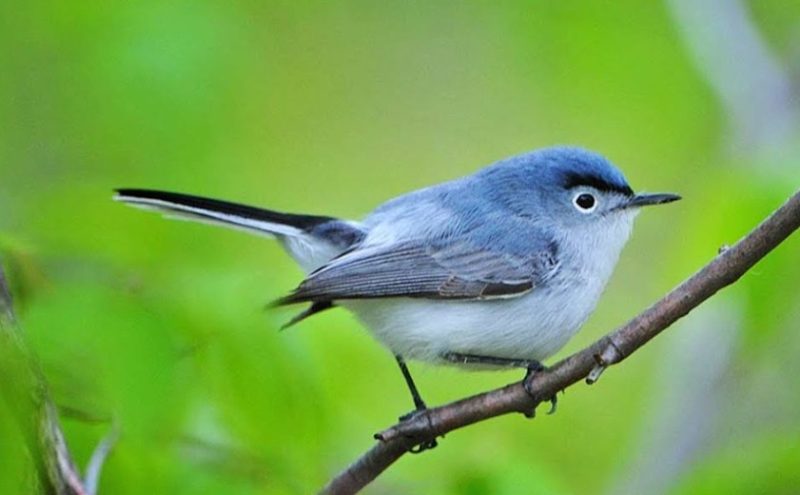
The Blue-gray Gnatcatcher is a small, slender songbird with a soft blue-gray body, white underparts, and a long, thin tail edged in white. Measuring about 10 to 12 cm (3.9 to 4.7 inches) long, it has a delicate appearance, with a thin, sharp bill well adapted for catching tiny insects in midair or gleaning from leaves.
This bird is identified by its restless behavior, constantly flicking its tail and flying acrobatically as it hunts for small insects and spiders. Its call is a high-pitched “zkreee,” and it often flutters near the canopy or shrubs, blending well with its environment. The Blue-gray Gnatcatcher’s active and agile foraging style makes it a distinctive presence in New Hampshire’s warmer months.
In New Hampshire, the Blue-gray Gnatcatcher is a summer resident found in deciduous woodlands, edges, and suburban gardens, primarily in USDA hardiness zones 4 to 7. It feeds almost exclusively on insects, especially gnats and other small flying bugs. It nests in small cup-shaped nests hidden in trees and shrubs.
Eastern Phoebe

The Eastern Phoebe is a small, plain songbird with a soft gray-brown back, pale underparts, and no distinctive wing bars or eye rings. It measures around 14 to 16 cm (5.5 to 6.3 inches) long and is known for its characteristic tail-wagging behavior, often seen pumping its tail up and down while perched.
Identification relies on its upright posture, plain coloring, and its distinct “fee-bee” song repeated several times. The Eastern Phoebe is an active flycatcher, catching insects in midair or gleaning from vegetation. It often nests on human structures like bridges, buildings, or under eaves, showing its adaptability to human presence.
In New Hampshire, the Eastern Phoebe breeds in open woodlands, farmland edges, and suburban areas, thriving in USDA zones 3 to 7. It arrives in early spring and remains through summer to raise young. Its diet consists mainly of flying insects, which it skillfully snatches during short flights from a perch.
Eastern Bluebird
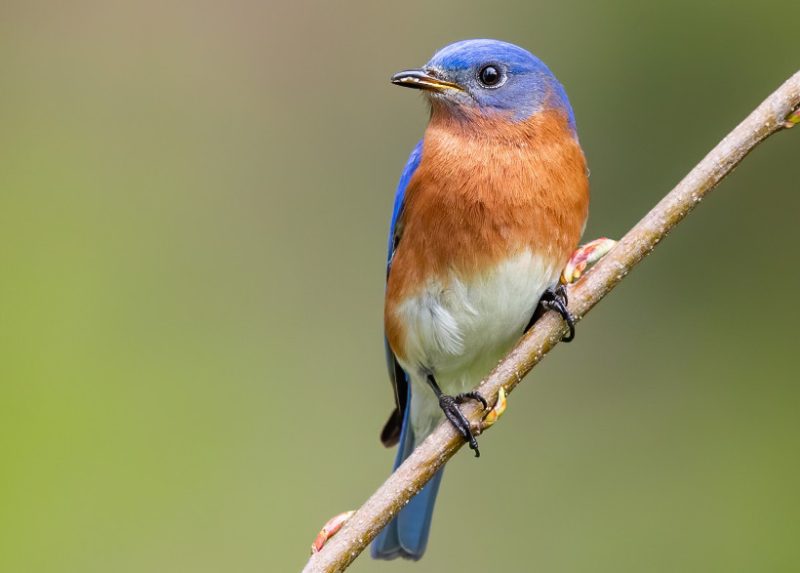
The Eastern Bluebird is a medium-sized songbird known for its striking bright blue upperparts and warm rusty-orange chest. The female has slightly duller colors but shares the same pattern. Measuring about 16 to 21 cm (6.3 to 8.3 inches) in length, it is a beloved species in New Hampshire due to its vibrant colors and charming presence.
This bird is easily identified by its direct flight, melodic song, and preference for open habitats with scattered trees. Eastern Bluebirds often perch on wires or fence posts as they scan for insects on the ground. Their diet includes insects, berries, and small fruits, varying by season. They nest in tree cavities or nest boxes, often benefiting from human-provided habitats.
In New Hampshire, the Eastern Bluebird is a common summer resident found in open fields, orchards, and suburban lawns, thriving in USDA hardiness zones 3 to 7. Conservation efforts have helped increase their population, making them a frequent and welcome sight in gardens and parks throughout the state.
American Goldfinch

The American Goldfinch is a small, vibrant songbird famous for its bright yellow plumage in males during the breeding season, contrasted with black wings and a black forehead. Females and non-breeding males have more muted olive-yellow tones. It measures about 11 to 13 cm (4.3 to 5.1 inches) long, with a conical bill suited for seed eating.
This bird is easily recognized by its cheerful, twittering flight call and its habit of feeding on seeds from plants like thistles, sunflowers, and asters. The American Goldfinch is highly social, often seen in flocks during the fall and winter months. Its flight pattern is undulating, and it often perches on thin branches or seed heads while feeding.
In New Hampshire, the American Goldfinch inhabits open fields, meadows, gardens, and suburban areas, thriving in USDA hardiness zones 3 to 8. It is mostly a summer breeder in the state but can sometimes be found during winter in milder years. Its diet consists primarily of seeds, especially from composite flowers, making it a specialized seed eater.
Dark-eyed Junco

The Dark-eyed Junco is a small, sparrow-like bird with a round head and a pale pink bill. Its plumage varies by region but typically features a slate-gray back and head with a white belly. Some populations show rusty or brown coloring. It measures about 14 to 16 cm (5.5 to 6.3 inches) long, making it a medium-sized sparrow.
This species is often spotted on the ground, foraging for seeds and insects in open woodlands, forest edges, and backyard feeders. The Dark-eyed Junco has a soft, musical trill and a sharp “tick” call. Its behavior includes hopping on the ground with quick, short bursts of flight when startled.
In New Hampshire, the Dark-eyed Junco is a common winter visitor and sometimes a year-round resident in USDA zones 3 to 6. It prefers coniferous or mixed forests in colder months but will also frequent suburban yards with feeders. Its diet changes seasonally, focusing on seeds in winter and insects during the breeding season.
Song Sparrow
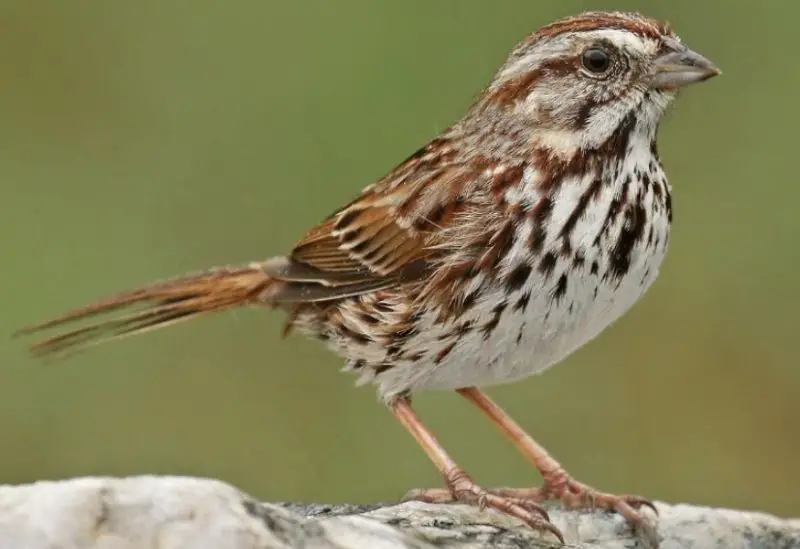
The Song Sparrow is a medium-sized sparrow characterized by streaked brown and gray plumage with a distinct central breast spot. It has a rounded head and a stout bill, measuring about 13 to 16 cm (5.1 to 6.3 inches) in length. Its plumage varies, but it typically blends well with grassy and shrubby habitats.
This bird is known for its rich, melodious song that varies greatly by individual and region. It forages on the ground or in low vegetation, feeding on seeds, insects, and small fruits. Song Sparrows exhibit territorial behavior during breeding and often nest close to the ground in dense vegetation.
In New Hampshire, the Song Sparrow is widespread across various habitats, including marshes, fields, and suburban areas, thriving in USDA hardiness zones 3 to 7. It is a common year-round resident or breeder, adapting well to human-altered landscapes. Its flexible diet helps it survive in diverse environments.
Savannah Sparrow
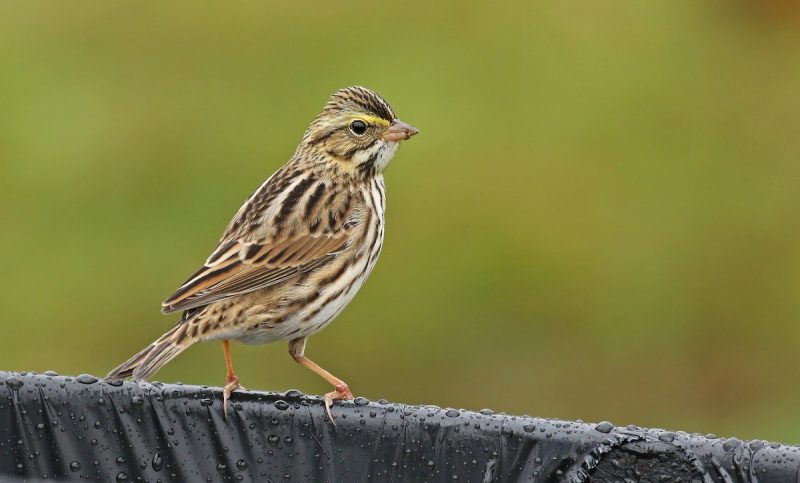
The Savannah Sparrow is a small sparrow with streaked brown and white plumage and a distinct yellowish patch above the eye. It has a relatively short tail and a fine, pointed bill. It measures about 12 to 15 cm (4.7 to 5.9 inches) long, blending well with grassy and open habitats.
This species is often seen on the ground or low vegetation, feeding primarily on seeds and insects. Its song is a buzzy trill that rises and falls in pitch. Savannah Sparrows are known for their skulking behavior but can be observed during migration or breeding when singing from exposed perches.
In New Hampshire, the Savannah Sparrow prefers open fields, meadows, and coastal grasslands, breeding in USDA zones 3 to 7. It is typically a summer resident but can be seen during migration in spring and fall. Its diet and habitat preferences make it a common but somewhat secretive bird in the state’s open landscapes.
Chipping Sparrow
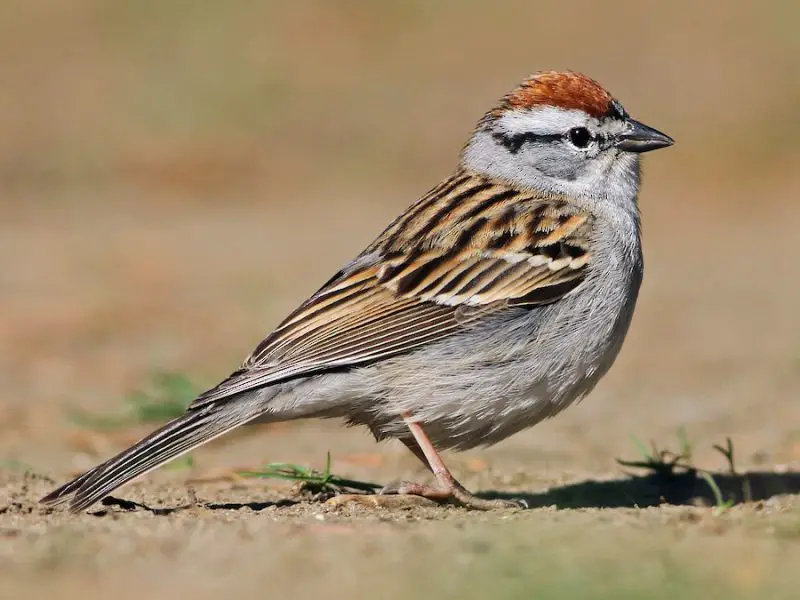
The Chipping Sparrow is a small, slender bird with a bright rusty-red crown, grayish face, and a clear white eyebrow stripe. It measures about 12 to 14 cm (4.7 to 5.5 inches) long. This species has clean, crisp plumage with minimal streaking, distinguishing it from other sparrows.
This bird is often found in open woodlands, parks, and suburban areas, where it forages on the ground or in low shrubs for seeds and insects. Its call is a rapid trill lasting several seconds, and it sings from exposed perches during the breeding season. Chipping Sparrows are often seen in loose flocks outside the breeding period.
In New Hampshire, the Chipping Sparrow breeds widely in USDA zones 3 to 7 and is a common summer resident. It prefers areas with scattered trees, open grassy patches, and residential yards. Its diet is flexible but relies heavily on seeds during fall and winter and insects in the warmer months.
Field Sparrow
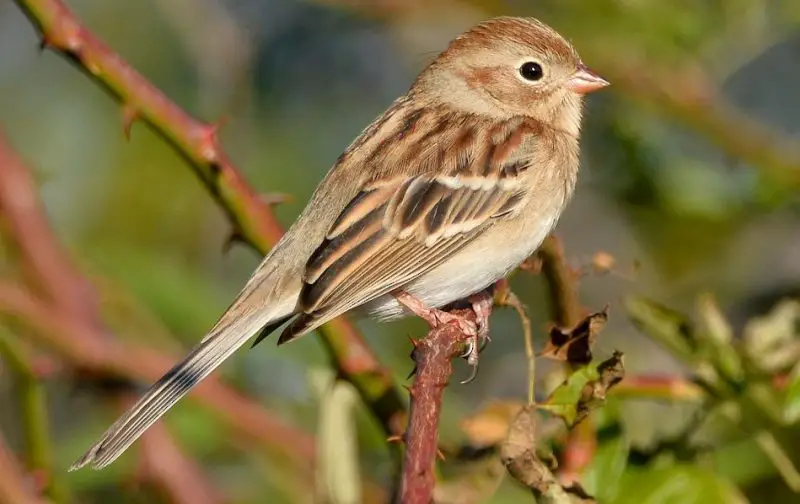
The Field Sparrow is a small, slender bird with soft grayish-brown upperparts and a pale, almost pinkish face. It has a distinct pink bill and a white eye ring, with subtle streaking on the back and a clean, pale underbelly. Measuring about 13 to 15 cm (5.1 to 5.9 inches) in length, it is a delicate and charming sparrow often found in open grassy areas.
Its behavior is generally shy and secretive, frequently staying low in brushy edges or tall grasses. The Field Sparrow’s song is a clear, rising whistle that sounds like a bouncing ball, which makes it easier to detect despite its elusive nature. It forages mainly on the ground for seeds and small insects, using quick hops to move about.
In New Hampshire, the Field Sparrow inhabits old fields, open woodlands, and shrubby edges, favoring USDA hardiness zones 4 to 7. It is primarily a summer breeder in the state, often seen in more rural and less forested areas. Its diet is mostly seeds during the fall and insects in the breeding season, supporting its active lifestyle.
Fox Sparrow
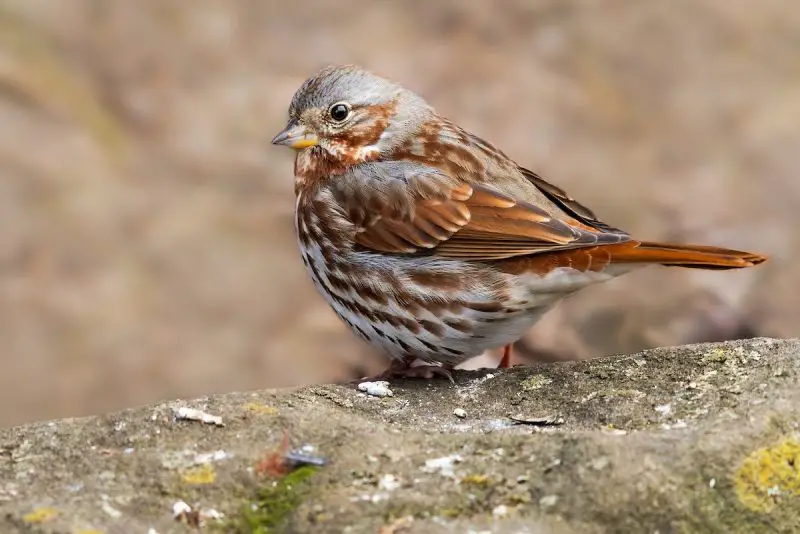
The Fox Sparrow is a large, robust sparrow with rich reddish-brown plumage marked by heavy streaks across its breast and flanks. It has a thick bill and a rounded head, measuring about 16 to 20 cm (6.3 to 7.9 inches) long. Its warm coloration and bold streaking help it blend into forest floors covered with leaves and debris.
This bird is often seen foraging on the ground, scratching leaf litter with both feet to uncover seeds and insects. The Fox Sparrow’s song is a musical, varied series of whistles and trills, often delivered from low shrubs or thickets. It is generally secretive and prefers dense underbrush for cover.
In New Hampshire, the Fox Sparrow is a migrant and winter visitor, found mainly in shrubby areas, forest edges, and thickets within USDA zones 3 to 6. It feeds on seeds, berries, and insects, adapting well to colder months by foraging close to the ground. Its presence is most noticeable during fall and early spring migration.
White-throated Sparrow
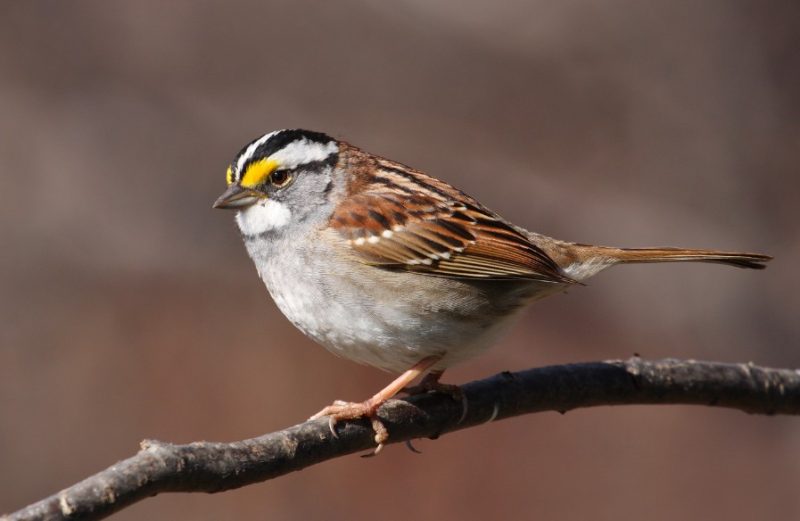
The White-throated Sparrow is a medium-sized sparrow distinguished by its striking white throat patch and yellow lores (the area between the eye and bill). It has brown streaked upperparts and grayish underparts. Measuring about 15 to 17 cm (5.9 to 6.7 inches) long, it is easily recognizable by both appearance and song.
This species is known for its clear, whistled song that sounds like “Oh sweet Canada Canada,” which is often heard in forests and shrubby habitats. It forages on the ground, digging through leaf litter for seeds and insects. The White-throated Sparrow is a social bird often seen in mixed-species flocks during migration and winter.
In New Hampshire, the White-throated Sparrow breeds in northern forests and mountainous regions, thriving in USDA zones 3 to 6. It spends winters in more southern areas but is sometimes found locally during colder months. Its adaptable diet allows it to exploit a variety of habitats, from dense woods to backyard feeders.
White-crowned Sparrow
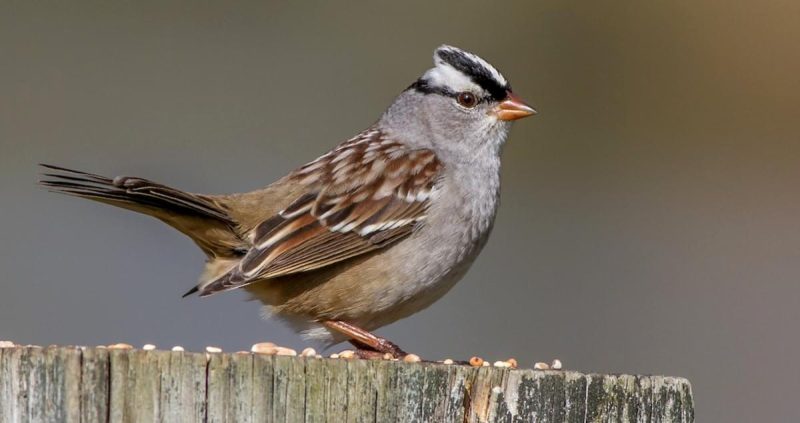
The White-crowned Sparrow is a medium-sized sparrow notable for its bold black-and-white striped crown and gray face and underparts. It measures about 15 to 17 cm (5.9 to 6.7 inches) long and has a stout bill adapted for seed eating. The striking head pattern makes it one of the easiest sparrows to identify.
This species is often seen on the ground or low vegetation, feeding on seeds, insects, and berries. Its song consists of clear, melodious whistles arranged in a series of phrases. White-crowned Sparrows exhibit territorial behavior during breeding but can form flocks in winter.
In New Hampshire, the White-crowned Sparrow is primarily a migrant and occasional breeder, favoring open woodland edges, fields, and shrubby areas in USDA zones 3 to 6. It is most commonly observed during migration seasons in spring and fall. Its diet is flexible, helping it adapt to a variety of environments.
House Sparrow

The House Sparrow is a small, stout bird with a chunky body, rounded head, and short tail. Males have gray crowns, black bibs, and chestnut brown patches on the sides of the head and neck, while females and juveniles are duller with brown and gray tones. It measures about 14 to 16 cm (5.5 to 6.3 inches) long and is one of the most common urban birds.
House Sparrows are highly adaptable and often live near humans, nesting in buildings, eaves, and nest boxes. Their behavior includes noisy social interactions and aggressive competition for nesting sites. Their diet is omnivorous, including seeds, grains, insects, and food scraps, allowing them to thrive in urban and suburban areas.
In New Hampshire, House Sparrows are widespread residents, found in towns, cities, farms, and suburban neighborhoods across USDA zones 3 to 7. They have successfully adapted to human-altered environments and are often seen around bird feeders and garbage areas. Their presence is sometimes controversial due to their aggressive behavior toward native species.
Pine Warbler
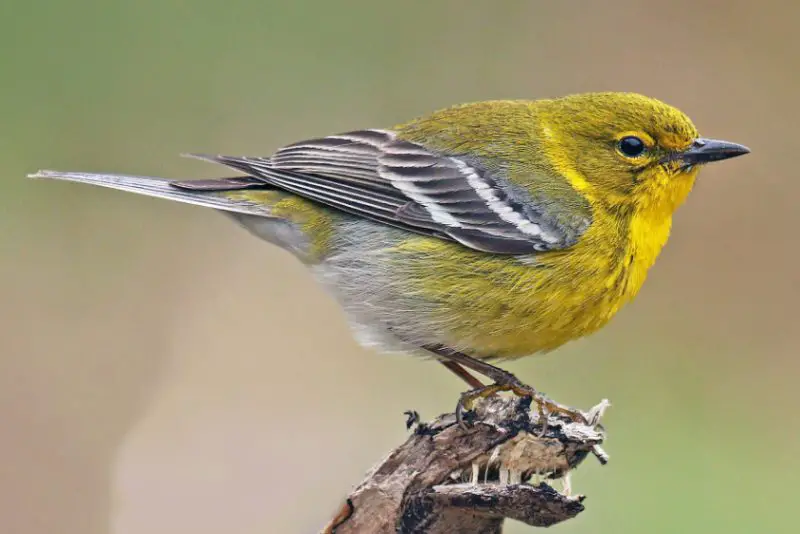
The Pine Warbler is a medium-sized warbler with a yellowish-green body, bright yellow throat and breast, and olive-green wings with two white wing bars. Males are brighter, while females and juveniles tend to have duller colors. Measuring about 13 to 15 cm (5.1 to 5.9 inches) in length, this bird is often seen foraging high in pine trees.
This warbler is recognized by its slow, musical trill and steady wing flicking behavior while perched. It feeds primarily on insects and spiders, but also consumes pine seeds, especially during winter months. The Pine Warbler forages by probing pine needles and bark crevices, often moving carefully among branches.
In New Hampshire, the Pine Warbler inhabits pine and mixed coniferous forests, thriving in USDA zones 3 to 7. It is mostly a summer resident, arriving in spring to breed and raising young in pine habitats. Its adaptation to pine forests makes it a specialized warbler of New England’s evergreen landscapes.
Yellow-rumped Warbler
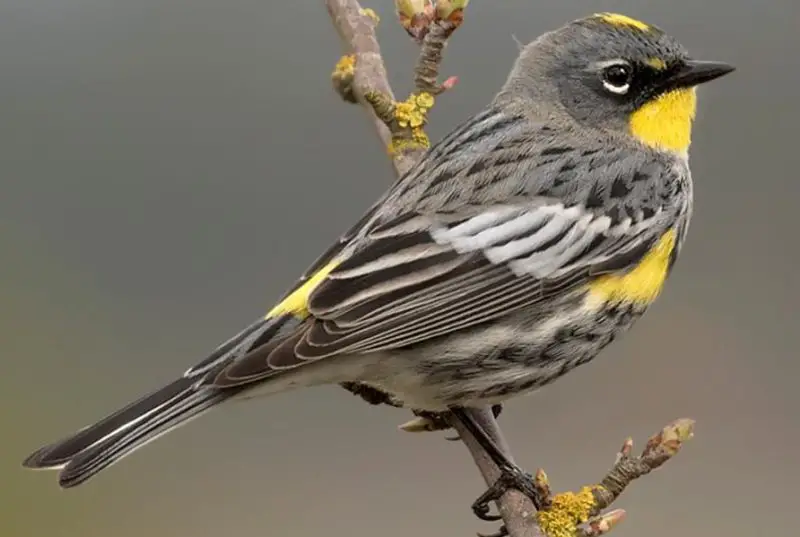
The Yellow-rumped Warbler is a strikingly patterned warbler with grayish-blue upperparts, white underparts, and bright yellow patches on the rump, sides, and crown. Males are more vividly colored than females. It measures about 14 to 15 cm (5.5 to 5.9 inches) in length and is one of the most widespread warblers in North America.
This species is highly adaptable and can be found in a variety of habitats, from coniferous forests to urban parks. Its distinctive chip and buzzy trill calls are often heard in flight or from treetops. The Yellow-rumped Warbler has a varied diet, feeding on insects, berries, and even waxy fruits that few other warblers can digest.
In New Hampshire, the Yellow-rumped Warbler is common during migration and the breeding season, inhabiting USDA zones 3 to 7. It prefers mixed woodlands, shrubby areas, and sometimes suburban habitats. Its ability to eat fruits in colder months allows it to remain later in the fall than many other warblers.
Common Yellowthroat

The Common Yellowthroat is a small warbler with bright olive-green upperparts, a yellow throat and chest, and a distinctive black mask across the eyes in males. Females and juveniles lack the black mask but have similar yellow coloring. It measures about 11 to 13 cm (4.3 to 5.1 inches) long and is often found in dense wetlands and brushy habitats.
This species is known for its loud, clear “witchity-witchity-witchity” song, often heard near marshes, wet meadows, and shrubby edges. The Common Yellowthroat forages close to the ground, gleaning insects from dense vegetation. Its skulking behavior makes it more often heard than seen.
In New Hampshire, the Common Yellowthroat breeds in wetland edges and brushy fields, primarily within USDA zones 3 to 7. It is a common summer resident, arriving in late spring and departing by early fall. Its diet consists mostly of insects and spiders, supporting its insectivorous lifestyle in marshy environments.
Magnolia Warbler
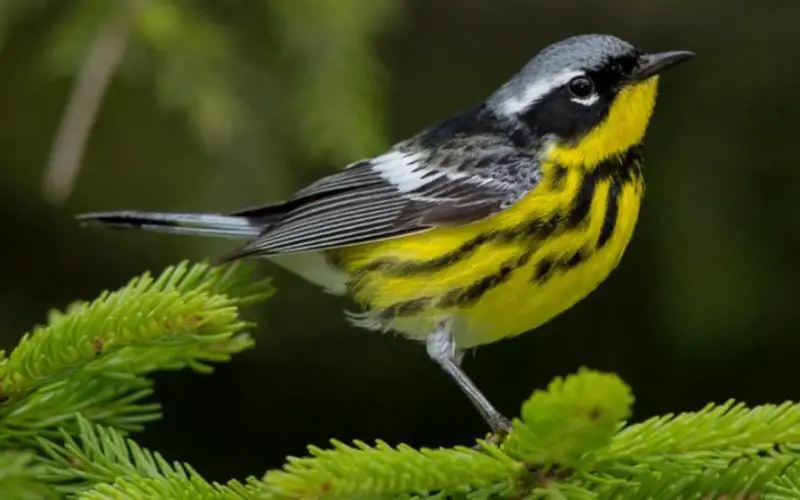
The Magnolia Warbler is a strikingly patterned warbler with bright yellow underparts, black streaking on the sides, and a bold black mask across the face. Its back is gray with white wing bars, and the male is more brightly colored than the female. It measures about 11 to 13 cm (4.3 to 5.1 inches) long and is known for its energetic behavior.
This warbler is often found in dense spruce and fir forests during the breeding season, flitting actively through branches as it searches for insects. Its song is a high-pitched, buzzy trill repeated several times. The Magnolia Warbler’s striking coloration and distinctive vocalizations make it a favorite among birdwatchers.
In New Hampshire, the Magnolia Warbler breeds in mature coniferous forests, thriving in USDA zones 3 to 6. It is a migratory species, arriving in spring and departing by late summer. Its insect-based diet supports its active foraging style in the dense northern forests.
Black-throated Green Warbler
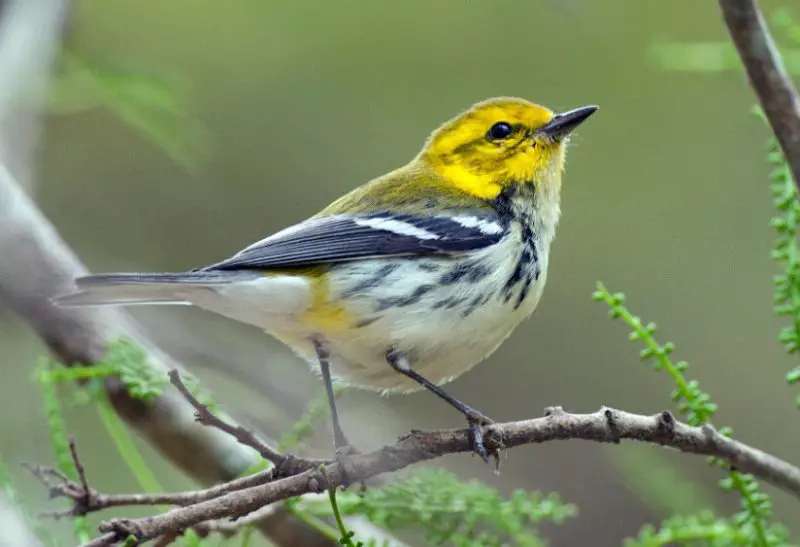
The Black-throated Green Warbler is a medium-sized warbler with olive-green upperparts, a yellow face and throat, and a contrasting black throat patch. It has white wing bars and streaking on the sides. Measuring about 11 to 13 cm (4.3 to 5.1 inches) long, it is a colorful and vocal bird.
This species is often found in mature coniferous and mixed forests, where it forages high in the canopy for insects and spiders. Its song is a buzzy trill that rises and falls in pitch, easily recognizable to birders. The Black-throated Green Warbler exhibits active and agile behavior as it moves through tree branches.
In New Hampshire, the Black-throated Green Warbler breeds in USDA zones 3 to 7, preferring dense forests with conifers and hardwoods. It is a summer resident that migrates south in the fall. Its insectivorous diet and habitat preferences make it a common warbler in the state’s northern woodlands.
Black-and-white Warbler
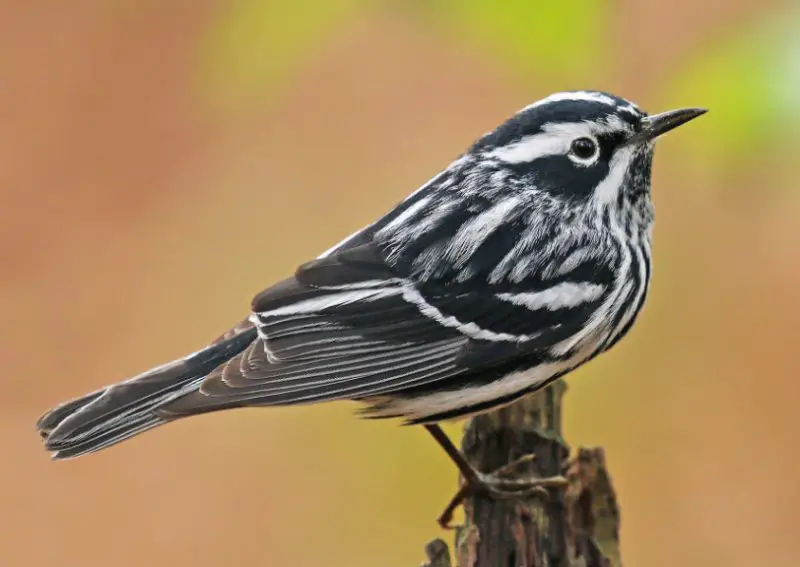
The Black-and-white Warbler is a small songbird characterized by striking black and white stripes across its head, back, and wings, giving it a zebra-like appearance. It measures about 11 to 13 cm (4.3 to 5.1 inches) long and has a slender, slightly curved bill adapted for gleaning insects. Its unique plumage makes it easy to identify among New Hampshire’s warblers.
This species is known for its distinctive behavior of creeping along tree trunks and branches like a nuthatch while searching for insects and spiders hidden in bark crevices. Its song is a high-pitched, buzzing trill that helps locate it in dense woodlands. The Black-and-white Warbler prefers mature deciduous and mixed forests with plenty of large trees.
In New Hampshire, it breeds in USDA zones 3 to 7 and is a summer resident. It arrives in late spring to nest and departs by early fall. Its insectivorous diet and tree-creeping habits make it an important part of forest ecosystems, helping control insect populations.
Ovenbird
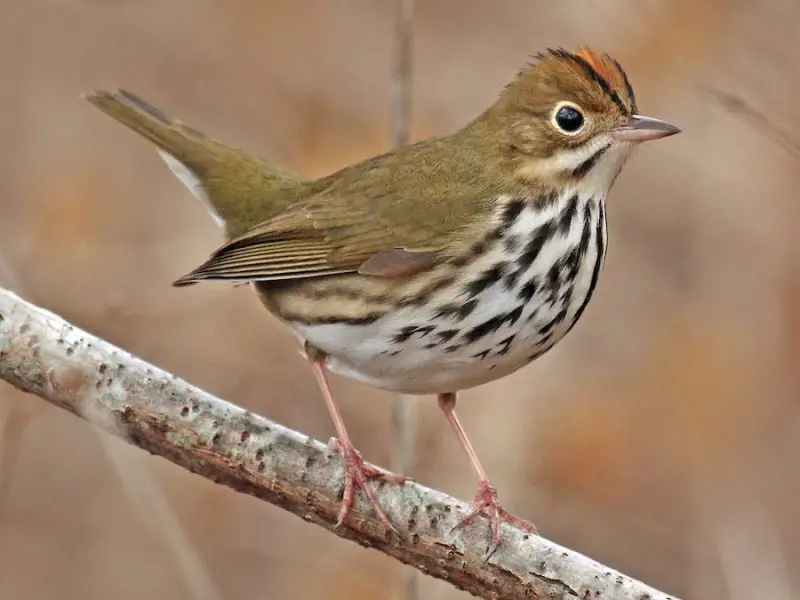
The Ovenbird is a medium-sized warbler with olive-brown upperparts, white underparts heavily streaked with black, and an orange crown bordered by black stripes. It measures about 14 to 16 cm (5.5 to 6.3 inches) long and is notable for its loud, ringing song that sounds like “teacher-teacher-teacher.”
Unlike many warblers, the Ovenbird spends much time on the forest floor, where it forages for insects and spiders by flipping leaf litter. It nests on or near the ground, building a dome-shaped nest that resembles a small oven—hence its name. Its behavior is secretive but its song is often heard throughout New Hampshire’s forests.
In New Hampshire, the Ovenbird breeds primarily in mature deciduous and mixed forests within USDA zones 3 to 7. It is a summer resident, arriving in late spring and departing by early fall. Its ground-foraging habits make it unique among warblers and a vital insect predator in forest habitats.
Northern Parula

The Northern Parula is a small warbler with a blue-gray back, bright yellow throat and chest, and a distinctive chestnut band across its upper breast. It measures about 10 to 12 cm (3.9 to 4.7 inches) in length and has white eye arcs that highlight its expressive face.
This species prefers wet forests with abundant mosses and lichens, often foraging high in tree canopies for insects and spiders. Its song is a buzzy trill followed by a high-pitched note, making it relatively easy to detect. The Northern Parula is active and agile, frequently flitting between branches.
In New Hampshire, the Northern Parula breeds in moist hardwood and mixed forests, especially in USDA zones 3 to 6. It is a summer resident, arriving in spring and leaving by late summer. Its reliance on mossy habitats links it closely to healthy forest ecosystems.
Chestnut-sided Warbler

The Chestnut-sided Warbler is a brightly colored warbler with white underparts, yellow crown and sides, and rich chestnut-colored streaks along the flanks. It measures about 11 to 13 cm (4.3 to 5.1 inches) long and is well-known for its striking plumage during the breeding season.
This warbler sings a clear, rising song often described as “pleased, pleased, pleased to meetcha,” which is commonly heard in shrubby areas and young forests. It forages actively in mid-level vegetation, gleaning insects and spiders from leaves and branches. The Chestnut-sided Warbler often favors regenerating forests and forest edges.
In New Hampshire, the Chestnut-sided Warbler breeds in USDA zones 3 to 7 and is a common summer resident. It thrives in young deciduous forests, old fields, and brushy habitats. Its diet is insectivorous, supporting its energetic lifestyle during the breeding season.
Blackburnian Warbler
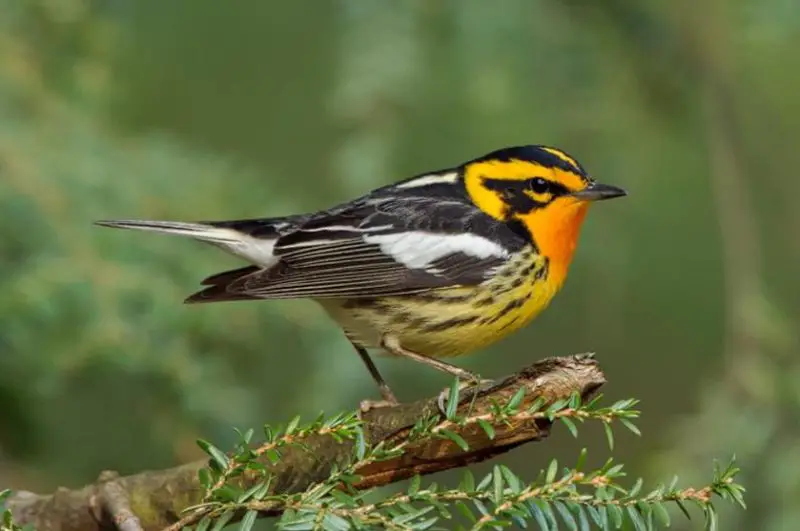
The Blackburnian Warbler is a striking warbler with a bright orange throat and face, contrasting with black streaks on its back and white underparts. It measures about 11 to 13 cm (4.3 to 5.1 inches) long and is considered one of the most colorful warblers found in New Hampshire.
This species prefers mature coniferous and mixed forests, where it forages high in the canopy for insects and spiders. Its song is a high-pitched, rapid series of notes that end with a buzzy trill, making it distinctive in the forest soundscape. The Blackburnian Warbler is active and agile, often seen darting among branches.
In New Hampshire, the Blackburnian Warbler breeds in USDA zones 3 to 6 and is a summer resident. It favors spruce and fir forests, contributing to the biodiversity of northern woodlands. Its vibrant colors and energetic behavior make it a favorite among birdwatchers in the region.
American Redstart

The American Redstart is a small, striking warbler known for its bold black and orange coloration in males, while females and juveniles display olive-gray and yellow tones. It measures about 12 to 13 cm (4.7 to 5.1 inches) long. This warbler is highly active, frequently flicking its tail and wings to startle insects into flight for easy capture.
Its behavior includes energetic foraging in the mid to upper levels of deciduous forests and woodlands. The male’s bright orange patches make it easy to spot during the breeding season. Its song is a high-pitched series of musical notes and phrases, often repeated rapidly.
In New Hampshire, the American Redstart breeds in USDA zones 3 to 7, favoring mature deciduous and mixed forests. It arrives in spring to breed and leaves by early fall. Its diet mainly consists of flying insects and spiders, making it an important insect predator in forest ecosystems.
Scarlet Tanager

The Scarlet Tanager is a medium-sized songbird with brilliant scarlet red plumage and contrasting black wings and tail in males. Females have olive-yellow bodies with darker wings. It measures about 17 to 19 cm (6.7 to 7.5 inches) in length. The male’s vibrant colors make it one of the most noticeable birds in New Hampshire’s summer forests.
This species prefers mature deciduous forests where it sings a series of hoarse, robin-like phrases. It is often heard before seen, as it tends to stay high in the canopy. Scarlet Tanagers forage for insects and fruit, gleaning from leaves and sometimes catching insects in midair.
In New Hampshire, the Scarlet Tanager breeds in USDA zones 3 to 7 during the summer. It arrives in late spring and departs by early fall. Its preference for mature forests and insectivorous diet links it closely to healthy woodland ecosystems.
Indigo Bunting
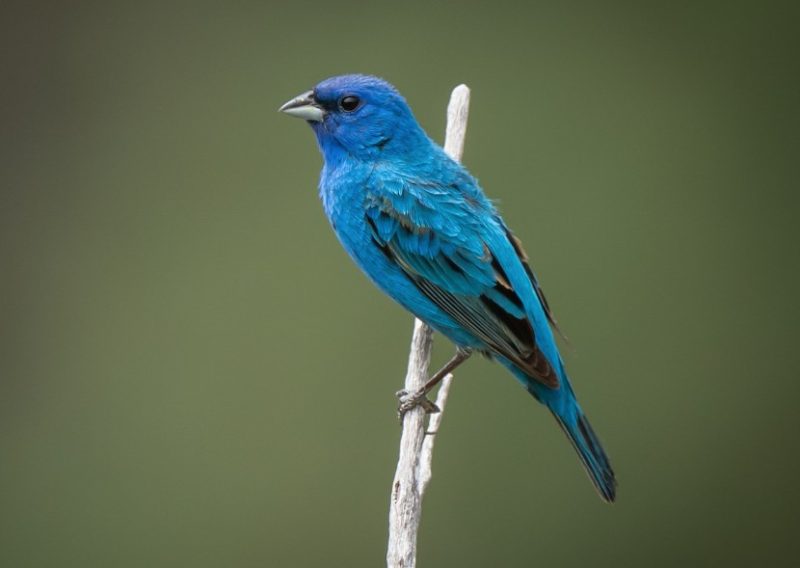
The Indigo Bunting is a small, vibrant songbird with brilliant blue plumage in males, while females are a more subdued brown with hints of blue. It measures about 11 to 13 cm (4.3 to 5.1 inches) long. The male’s dazzling color makes it a favorite among birdwatchers during the breeding season.
This species inhabits open woodlands, forest edges, and brushy areas. Its song is a sweet, musical warble that it often sings from exposed perches. Indigo Buntings primarily feed on seeds, berries, and insects, adjusting their diet seasonally.
In New Hampshire, the Indigo Bunting breeds in USDA zones 4 to 7 and is a common summer resident. It arrives in late spring and leaves by early fall. Its habitat preference includes shrubby edges and open forest patches where it nests and forages.
Eastern Towhee
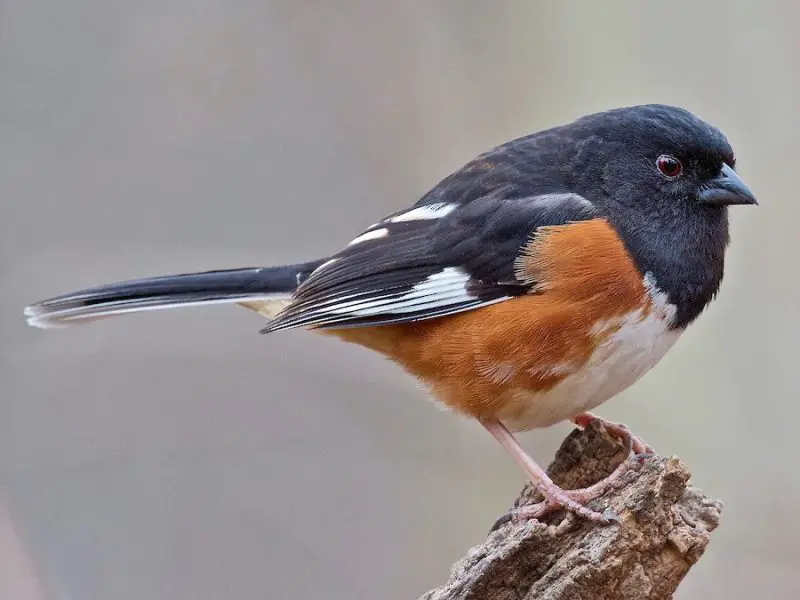
The Eastern Towhee is a large sparrow with striking black, white, and rufous coloration in males, and brown replacing the black in females. It measures about 18 to 20 cm (7.1 to 7.9 inches) long. Its bold pattern and loud call make it one of the more easily noticed sparrows in New Hampshire’s brushy areas.
This bird is often heard before seen, with its distinctive “drink-your-tea” song. It forages on the ground by scratching leaf litter with both feet, flipping debris to uncover seeds and insects. Its behavior is mostly secretive, preferring dense underbrush and thickets.
In New Hampshire, the Eastern Towhee breeds in USDA zones 4 to 7, favoring forest edges, brushy fields, and suburban thickets. It is a common summer resident and important for controlling insects and dispersing seeds in its habitat.
Brown Creeper

The Brown Creeper is a small, slender bird with mottled brown and white plumage that provides excellent camouflage on tree bark. It measures about 12 cm (4.7 inches) long and has a slender, curved bill ideal for probing bark crevices for insects.
This species is known for its unique behavior of spiraling up tree trunks while searching for insects and spiders hidden beneath the bark. Its call is a high, thin “seet,” often heard in mature forests. Brown Creepers are shy and often go unnoticed despite their active foraging.
In New Hampshire, the Brown Creeper inhabits mature deciduous and mixed forests in USDA zones 3 to 7. It is a year-round resident, relying on its insectivorous diet to survive through cold winters. Its role as a bark-foraging specialist makes it an important part of forest ecosystems.
Red-breasted Nuthatch
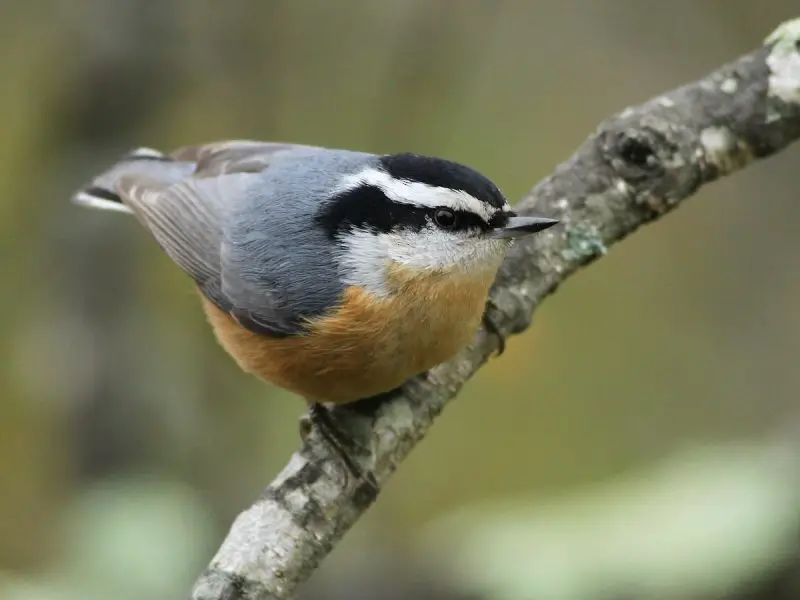
The Red-breasted Nuthatch is a small, agile bird with a compact body and a distinctive black stripe running through its eye. It has a blue-gray back, rusty underparts, and a white face with a black crown. Measuring about 11 to 12 cm (4.3 to 4.7 inches) in length, this bird is known for its energetic movements and quick, sharp calls.
This species is often seen creeping headfirst down tree trunks and branches, searching for insects and seeds hidden in bark crevices. Its nasal, “yank-yank” call is a common sound in coniferous forests. Red-breasted Nuthatches are frequent visitors to bird feeders in winter, especially those offering sunflower seeds and suet.
In New Hampshire, the Red-breasted Nuthatch inhabits coniferous and mixed forests across USDA zones 3 to 7. It is a year-round resident but may be more abundant during irruptive years when food is scarce farther north. Its diet consists primarily of insects during summer and seeds in winter, reflecting its adaptability to seasonal changes.
Carolina Wren
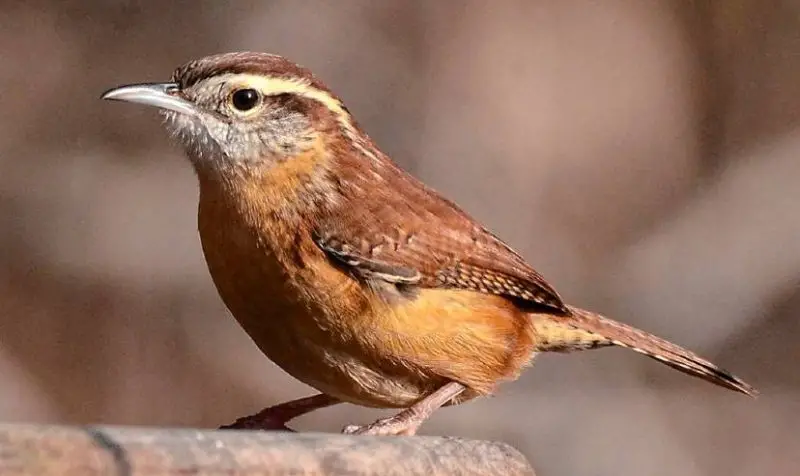
The Carolina Wren is a medium-sized wren with warm reddish-brown upperparts, a white throat and eyebrow stripe, and buffy underparts. It measures about 12 to 14 cm (4.7 to 5.5 inches) in length. This bird is vocal and energetic, often seen hopping around in thick shrubs and dense undergrowth.
Known for its loud and melodious song that sounds like “teakettle, teakettle, teakettle,” the Carolina Wren is highly territorial. It forages primarily for insects and spiders on or near the ground but can also eat small fruits. This species readily adapts to human environments, frequently nesting in garden structures and birdhouses.
In New Hampshire, the Carolina Wren is more common in the southern parts of the state, inhabiting USDA zones 5 to 7. It is a year-round resident in suitable habitats, especially in dense brushy areas and suburban gardens. Its adaptability and strong territorial behavior make it a resilient and familiar species.
Ruby-throated Hummingbird
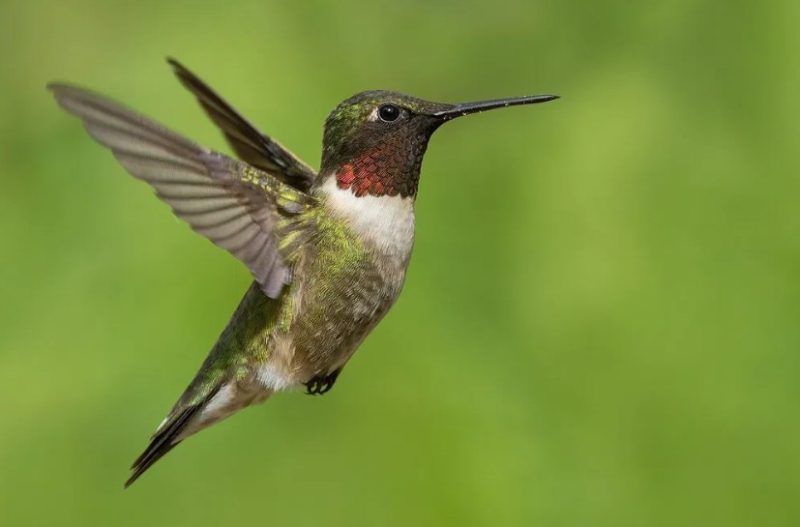
The Ruby-throated Hummingbird is a tiny, iridescent bird with metallic green upperparts and a white underbelly. Males are especially notable for their bright, ruby-red throat patch, which can flash vividly in sunlight. The bird measures about 7 to 9 cm (2.8 to 3.5 inches) long, making it one of the smallest birds in New Hampshire.
This hummingbird is famous for its hovering flight and rapid wing beats, which produce a humming sound. It feeds primarily on nectar from flowers but also consumes small insects and spiders for protein. Males perform elaborate aerial displays during the breeding season to attract females.
In New Hampshire, the Ruby-throated Hummingbird breeds during the summer months in USDA zones 4 to 7. It migrates south for the winter, traveling long distances. Its presence is closely tied to flowering plants and feeders, making it a favorite among gardeners and bird enthusiasts.
Baltimore Oriole

The Baltimore Oriole is a medium-sized songbird with striking bright orange and black plumage in males, while females have more subdued yellow-orange coloring. It measures about 17 to 20 cm (6.7 to 7.9 inches) long. Its bold colors and melodic song make it a standout in New Hampshire’s spring and summer landscapes.
This species is known for its intricate hanging nests woven from fibers, often suspended from tree branches. Baltimore Orioles feed on insects, fruit, and nectar, frequently visiting feeders offering orange halves and sugar water. Their song is a series of rich, flutelike whistles.
In New Hampshire, the Baltimore Oriole breeds in USDA zones 4 to 7, favoring open woodlands, parks, and suburban areas with deciduous trees. It arrives in late spring and departs by early fall. Its diet and nesting habits make it an important part of the local ecosystem and a favorite bird for many observers.
FAQ about Small Birds in New Hampshire
What are some common small birds found in New Hampshire?
New Hampshire is home to many small bird species such as the Black-capped Chickadee, Tufted Titmouse, White-breasted Nuthatch, House Wren, and Winter Wren. These birds are often found in forests, suburban areas, and parks throughout the state.
How can I identify small birds in New Hampshire?
Identification often depends on a bird’s size, plumage colors, distinctive markings, behavior, and song. For example, the Black-capped Chickadee has a black cap and bib with white cheeks, while the Tufted Titmouse features a gray crest and bright eyes. Listening to bird calls can also help with identification.
When is the best time to observe small birds in New Hampshire?
Spring and summer are excellent times to see a wide variety of small birds, as many species are breeding and more active. Fall migration can also bring different species through the area. Early mornings are generally the best time to observe bird activity.
Where do small birds in New Hampshire typically live?
Small birds inhabit diverse habitats including deciduous and mixed forests, wetlands, shrubby areas, and suburban gardens. Species like the House Wren prefer dense brush, while others like the White-breasted Nuthatch are often found on mature trees.
What do small birds in New Hampshire eat?
Their diets vary by species but commonly include insects, spiders, seeds, and berries. Warblers and nuthatches primarily eat insects, while finches and sparrows rely more on seeds. Many small birds also visit backyard feeders for sunflower seeds, suet, and nectar.
Are small birds in New Hampshire year-round residents?
Some species like the Black-capped Chickadee and White-breasted Nuthatch are year-round residents. Others, such as the Ruby-crowned Kinglet or Magnolia Warbler, are migratory and only present during specific seasons like spring and summer.
How can I attract small birds to my backyard in New Hampshire?
Providing native plants, bird feeders stocked with seeds (such as sunflower seeds), fresh water, and shelter like shrubs or nesting boxes can attract small birds. Avoiding pesticides and keeping cats indoors also helps create a safe environment for birds.
Are any small birds in New Hampshire threatened or endangered?
Most small birds in New Hampshire have stable populations, but habitat loss and climate change can impact some species. Conservation efforts by local and national organizations help protect critical habitats to support bird populations.
Can I feed hummingbirds in New Hampshire?
Yes! Ruby-throated Hummingbirds are common in New Hampshire during summer. You can attract them by providing sugar water feeders and planting nectar-rich flowers such as bee balm, trumpet vine, and cardinal flower.
What should I do if I find an injured small bird in New Hampshire?
If you find an injured or orphaned bird, contact a licensed wildlife rehabilitator or local animal control for guidance. Avoid handling the bird excessively and keep it in a quiet, warm, and secure container until professional help is available.

